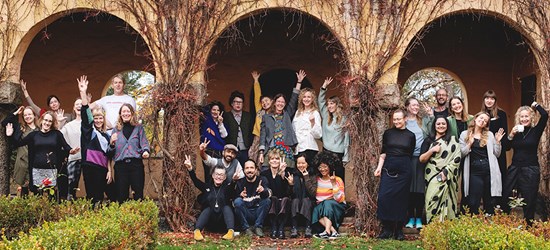Julie Forchhammer from Klimakultur attended the Creative Climate Leadership programme together with Vilma and went through so many of the same feelings and learning experiences as Vilma is describing so well in this text.
The blog post was first published on Frame Contemporary Art Finland’s blog, March 2023. Thank you to Frame Contemporary Art Finland where this text was first published, and to Vilma Leminen for letting Klimakultur publish the piece.
-------------------------------------------------------------------------------------------------------------
Vilma Leminen reflects on the ways in which Julie’s Bicycle’s Creative Climate Leadership Programme transformed their outlook on the relationship between arts and justice-focused climate action:
How can arts and creativity connect with climate and justice?
In the Spring of 2022, I took part in the Creative Climate Leadership programme alongside my work and position as Programme Assistant at Frame Contemporary Art Finland. The Creative Climate Leadership (in short CCL) is a training and transformation programme facilitated and led by Julie’s Bicycle, a London-based not-for-profit organisation empowering the arts and creative sector in responding to the ecological and climate crisis. The Scandinavia 2022 cohort of the programme was organised with arts and cultural workers based in Finland, Sweden, Denmark, and Norway.
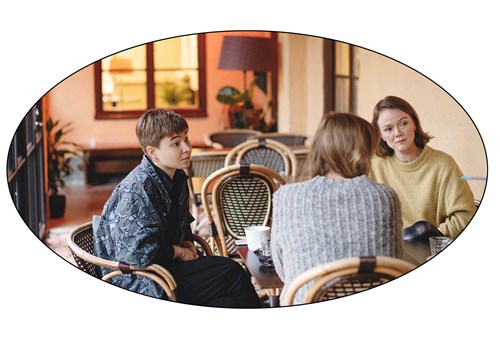 (Vilma Leminen, left. Tove Skeidsvoll, right. Photo: Sara Kollberg.)
(Vilma Leminen, left. Tove Skeidsvoll, right. Photo: Sara Kollberg.)
It gathered artists across various disciplines with a shared sentiment of weaving together climate and justice with arts and creative practices. Alongside establishing a network across Nordic countries, the programme supports the realisation of individual legacy projects building long-term climate action initiatives and leadership work. In this blog text, I reflect on the experience of the programme, and the ways it transformed the outlook I had on the relationship between arts and climate action.
As I embarked on the journey of the Creative Climate Leadership programme, I was not prepared to find myself wholeheartedly transformed and empowered by the people and community. Receiving the opportunity to listen and engage in the work, activism, and research of climate activists, environmental scientists, artists, Indigenous rights activists, cultural workers and grassroots organisations, impacted my sense of agency in diving head-first into climate action.
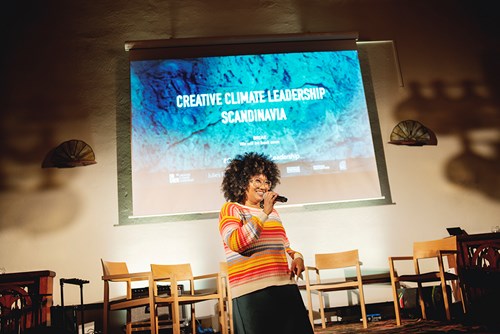
(Charise Johnson, Julie's Bicycle. Photo: Sara Kollberg.)
The conversations centred on how the arts and creative fields can mobilise for changing the destructive and damaging systems we live in. The programme suggested ways arts and culture can embed climate justice, climate reparations and regenerative thinking into action and cultural policy – and how to practise creative leadership that safeguards the well-being, rights, and safety of human and more-than-human lifeways. Discussions sprung out of the need to transform and to be transformed; to recognise the seeds and the relationships needed to cultivate change towards justice.
At the heart of the Creative Climate Leadership programme is acknowledging and confronting the root causes of the climate emergency through the lens of climate justice. There is an unignorable inequity and injustice between those who are responsible for climate breakdown, historically and today, and those who shoulder the largest threats and burdens of the devastating and life-threatening impacts of the climate and environmental crisis.
The framework of climate justice is deeply entwined with Indigenous rights, anti-racism, disability rights, LGBTQI+ rights, labour rights, as well as land justice, rights of nature, and environmental justice. Climate justice calls for centring the voices and lives of people and communities who are at the frontlines of the climate crisis locally, nationally, and globally. Here, arts and culture have a vital role in supporting frontline community leadership and platforming stories, experiences, and voices rendered invisible by structures of exploitation, colonisation and injustice.
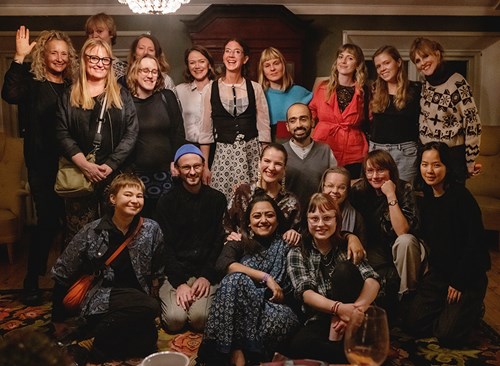
Recognising the climate crisis as a complex environmental, social, and political emergency illuminates the central role of arts and culture in the crisis, and the abilities of arts and culture in taking action. A significant takeaway of the CCL programme was gaining trust in the capabilities of arts and culture in steering impactful societal change and being a vital mediator in political climate conversations such as COP26 and COP27. This was foundational for me in gaining courage and approval to approach sustainability work not through environmental and physical sciences, but through arts and culture.
While attending the CCL programme and understanding the wide potential for change that is embedded in arts and culture, the day-to-day sustainability work at Frame was primarily concerned with the EcoCompass process where I was organising waste management plans and listing office chemicals. Although the EcoCompass process provides useful tools for improving ecological sustainability that is urgently needed, especially in industrial companies, organising safety sheets for dishwasher liquid in an office of 15 people felt disheartening – having in mind how much more of an impact an art organisation with wide national and international networks could have through programming that emphasises the cultural, social, and ethical dimensions of the crisis. I felt a pressing conviction that arts organisations such as Frame, can direct resources and capabilities towards advancing more influential, radical and responsive advocacy work by facilitating and mobilising arts-led climate initiatives and conversations in the field such as the well-received Eco-seminar in 2020. Similarly, the newly launched Island of Kinship: A Collective Manual for Sustainable and Inclusive Art Institutions is a valuable initiation for deepening knowledge and practices of ecological sustainability and climate justice work with art institutions across Europe.
The CCL programme and the work of Julie’s Bicycle were eye-opening for seeing the growing interest and momentum in realising arts-led climate action and climate justice initiatives worldwide. Imperative to the growing engagement is acknowledging that we can’t face the climate emergency without arts and culture.
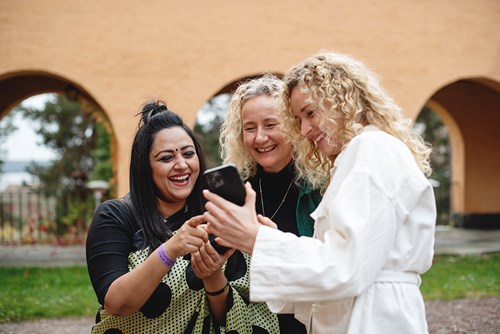
(Sharmin Sultana Sumin, Julie Forchhammer, Jasmine Alakari. Photo: Sara Kollberg.)
As the Island of Kinship project puts forth, art institutions (such as Frame) can have a valuable role in deepening coalitions, conversations, and capacity within their fields and networks. Collecting insights and statistics on the fields’ needs and strengths in building resilience, creative change, and adaptation would support mobilising communal efforts and collaboration leading to sustainability transformations and action. As vocalised during the CCL programme, insights and resources allocated for advancing climate and sustainability initiatives are key for driving through long-term change-work in the field.
A just transition equals also a transition from fossil fuel-based infrastructure to equitable, regenerative, and renewable energy-based systems that do not violate human rights. At the core of the transition lies recognising fossil fuel-based capitalism, and colonial legacies thereof, as the main drivers behind climate and social injustice. As an arts organisation, there are many ways to resist the fossil fuel industry.
Julie’s Bicycle’s Creative Climate Justice Guide (2022) exemplifies actions that can further divestments and halting the field. One action is switching organisational finances away from banks that fund fossil fuel infrastructure. Another action is saying no to sponsorships or collaboration possibilities with companies, foundations, and funders that have ties or investments in fossil fuels. A third action is tapping into the capacities of arts and culture by taking part in climate and environmental justice campaigns and awareness building within the field as well as in society at large. Public programmes and projects supporting justice focused artistic and creative initiatives may help amplify intersectional climate action while building collaboration between organisations, artists, activists, policymakers, local communities and researchers.
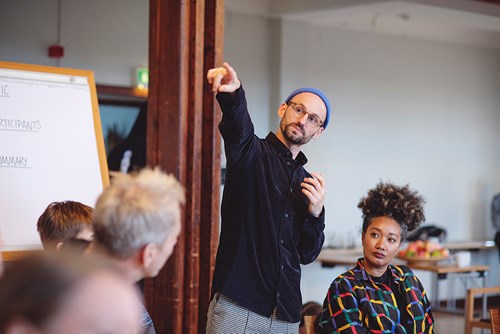 (Diego Galafassi, Charise Johnson. Photo: Sara Kollberg.)
(Diego Galafassi, Charise Johnson. Photo: Sara Kollberg.)
As voiced during the Creative Climate Leadership programme; arts and culture can change hearts and minds. At the heart of it all, lies recognising the power of arts and culture in activating imaginations, sensibilities, and frameworks to embrace ways of living and dreaming together.
I wish to express my warmest thanks to Julie’s Bicycle and the CCL-Scandinavia cohort and participants for the valuable and formative discussions, help and sharings. I also want to thank the team at Frame for giving support.
Vilma Leminen is an art educator and producer based in Helsinki. They worked at Frame Contemporary Art Finland as a Programme Assistant in the year 2021 and 2022.
All photos: CCL Summit Sweden 2022, by Sara Kollberg
